Space
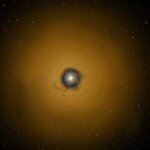
Astronomers can look back in time by gathering light from distant stars that was sent billions of years ago. Another way to learn about the past is to study similar stars to our own, but at a much younger age.
New work studying the young star TW Hydrae, located about 190 light-years from Earth in the southern constellation Hydra the Water Snake, suggests that our Sun was both active and "feisty" in its infancy, growing in fits and starts while burping out bursts of X-rays.
TW Hydrae is an orange, type K star weighing about 80 percent as much as our Sun. It is about 10 million…
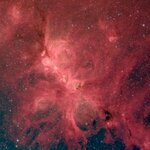
While the Orion Nebula is one of the closest stellar nurseries to Earth and that makes for great viewing in backyard telescopes, it is not the most prolific star-forming region in our galaxy. That distinction may go to the Cat's Paw Nebula, otherwise known as NGC 6334, formally known as NGC 6334, which is experiencing a "baby boom."
NGC 6334, in the constellation Scorpius, spans a distance of about 50 light-years and covers an area on the sky slightly larger than the full Moon.
It is an area of extremes. The
Cat's Paw Nebula
contains about 200,000 suns' worth of material that is…
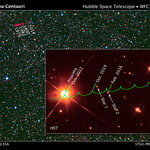
In October 2014 and February 2016 Proxima Centauri, the red dwarf star nearest to our sun, passes in front of two other stars. Astronomers plotted Proxima Centauri's precise path in the heavens and predicted the two close encounters using data from NASA's Hubble Space Telescope, meaning two opportunities in the next few years to hunt for Earth-sized planets around it.
Red dwarfs are the most common class of stars in our Milky Way galaxy. Any such star ever born is still shining today. There are about 10 red dwarfs for every star like our sun. Red dwarfs are less massive than other stars…
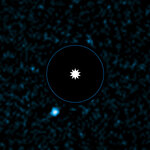
A team of astronomers using ESO’s Very Large Telescope has imaged a faint object moving near a bright star. With an estimated mass of four to five times that of Jupiter, this exoplanet, named HD 95086 b, would be the lightest planet to be directly observed outside the Solar System.
Although nearly a thousand exoplanets have been detected indirectly — most using the radial velocity or transit methods — and many more candidates await confirmation, only a dozen exoplanets have been directly imaged. Nine years after ESO's Very Large Telescope captured the first image of an exoplanet, the…

Asteroid 1998 QE2 will be its closest to Earth on Friday at 1:59 p.m. Pacific time. At 1.7 miles wide it is one of the larger asteroids to swing by Earth - about the size of the rock that wiped out the dinosaurs.
Luckily, Asteroid 1998 QE2 will be a comfortable 3.6 million miles away.
Astronomical bonus: it even has its own moon, a smaller rock circling it that is about about 2,000 feet wide.
A sequence of radar images of asteroid 1998 QE2 was obtained on the evening of May 29, 2013, by NASA scientists using the 230-foot (70-meter) Deep Space Network antenna at Goldstone, Calif.,…

In the half year since I wrote last September, the CubeSat field has greatly moved forward. Seven CubeSats have launched since that last blog include ESTCube-1 (solar sail test), Pegasus (testing carbon nanocubes for thermal control), the first PhoneSats (testing commodity smart phones in space), SOMP (testing software-defined radio), BeeSat (testing reaction wheels), and AAUSAT3 (testing arctic ship tracking), and FITSAT-1 (testing a high speed transmitter).
We are still at a cusp when CubeSats are few-- a couple dozen in a year, spread out across the world-- but growing. I…

Saturn's moon Titan might be in for some wild weather as it heads into its spring and summer, if two new models are correct.
Scientists think that as the seasons change in Titan's northern hemisphere, waves could ripple across the moon's hydrocarbon seas, and hurricanes could begin to swirl over these areas, too. The model predicting waves tries to explain data from the moon obtained so far by NASA's Cassini spacecraft. Both models help mission team members plan when and where to look for unusual atmospheric disturbances as Titan summer approaches.
Titan's north polar region, which is…
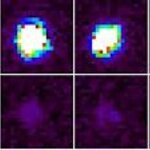
During the Bush administration, NASA began monitoring the Moon for explosions - they have turned out to be more common than previously believed, happening hundreds of times each year.
Smart Science 2.0 readers are already wondering how there can be an 'explosion' when the Moon has no oxygen atmosphere. Lunar meteors hit the ground with so much kinetic energy that even a pebble can make a crater several feet wide and so the flash of light comes not from combustion but rather from the thermal glow of molten rock and hot vapors at the impact site. No oxygen or combustion needed.
On Friday…

Uranus and Neptune have a lot in common, climate-wise, even though Uranus is tipped on its side with the pole facing the sun during winter. They are both home to extreme winds blowing at speeds of over 1000 km/hour, they have hurricane-like storms as big as our whole planet and immense weather systems can last for years.
But what about their origins? Do the atmospheric patterns arise from deep down in the planet, or are they confined to shallower processes nearer the surface? Understanding the atmospheric circulation is not simple for a planet without a solid surface,…

4C+29.30, a galaxy located some 850 million light years from Earth, has a new composite image which shows how the intense gravity of a supermassive black hole can be tapped to generate immense power.
This multi-wavelength view reveals that the radio emission of 4C+29.30 comes from two jets of particles that are speeding at millions of miles per hour away from a supermassive black hole at the center of the galaxy. The estimated mass of the black hole is about 100 million times the mass of our Sun. The ends of the jets show larger areas of radio emission located outside the galaxy…